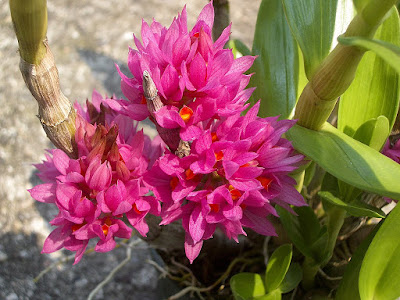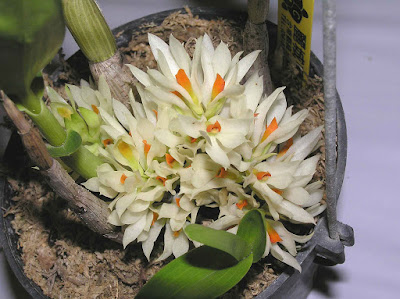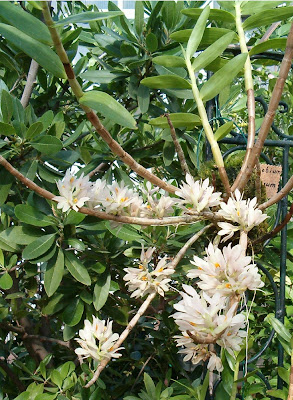Dendrobium bracteosum is native to New Guinea. In Papua, plants were encountered near Port Praslin and Punam on the island of New Ireland (New Mecklenburg), at an altitude of around 500 m, on the island of Rossel and the Sepik region near Aitape (Eitape) at an altitude of 20-400 m) and along the north coast western Papua New Guinea at an altitude of 20 m.
Dendrobium bracteosum, also called as The Bracted Dendrobium, Dendrobium bracteosum var. album, Dendrobium bracteosum var. roseum, Dendrobium chrysolabium, Dendrobium chrysolabrum, Dendrobium dixsonii, Dendrobium dixsonii var. eborinum, Dendrobium eitapense, Dendrobium leucochysum, Dendrobium novae-hiberniae, Dendrobium quadrialatum, Dendrobium trisaccatum, Pedilonum bracteosum, Pedilonum eitapense, Pedilonum leucochysum, Pedilonum quadrialatum, is a species of the genus Dendrobium. This species was described by Heinrich Gustav Reichenbach in 1886.
IDENTIFY DENDROBIUM BRACTEOSUM
Dendrobium bracteosum is native to New Guinea. In Papua, plants were encountered near Port Praslin and Punam on the island of New Ireland (New Mecklenburg), at an altitude of around 500 m, on the island of Rossel and the Sepik region near Aitape (Eitape) at an altitude of 20-400 m) and along the north coast western Papua New Guinea at an altitude of 20 m. In Irian Jaya (western New Guinea) plants meet in marshy areas along the river Noord. They usually grow in forests on trees or near the ground, on mangrove trees in lowland rainforests, from sea level up to 700 m, but they were encountered even at an altitude of 1200 m.
It is a small to medium sized, hot to warm growing epiphyte, which reaching 25-50 cm in height, with tufted, erect or pendulous, terete, slender at the base, fleshy and thicker above, to 9 noded, 20-40 cm long, yellowish stems covered in papery sheaths and carrying up to 6, ligulate to oblong, tapering at both ends, coriaceous, 4-8 cm long, rich green leaves.
The Bracted Dendrobium blooms in the spring through fall on 1 1/2" (4 cm) long, pendulous, dense racemes that have fasciculate, ball-like clusters, arising from the nodes near the apex of older psuedobulbs, with 3 to 8, scented, waxy flowers. The flowers are 1.3-2.5 cm long and do not open completely. They are extremely long-lasting and can stay in perfect condition for up to 5-6 months. The petals of both whorls may be white, greenish, yellow, pink, purple or dark red. Regardless of the color of the flakes of both whorls, the sharp lip is always red or yellow and orange, although it may have pale violet stripes.
DENDROBIUM BRACTEOSUM CARE AND CULTURE
Cultural information should only be used as a guide, and should be to be adapted to suit you. Your physical location; where you grow your plants, how much time you have to devote to their care, and many other factors, will need to be taken into account. Only then can you decide on the cultural methods that best suit you and your plants.
Light:
Dendrobium bracteosum needs a light level of 10000-20000 lux.
Temperature:
Throughout the year the average day temperature is 30-31 ° C, night 20-21 ° C, which gives a daily amplitude of 9-11 ° C.
Humidity:
The Bracted Dendrobium needs the humidity of almost 75% throughout the year. However, at night the humidity is 90-100%, but during the dry season, the humidity during the day may drop even up to 35%.
Substrate, growing media and repotting:
Dendrobium bracteosum can be mounted on tree-fern rootstocks or cork, provided that high humidity is ensured and at least once a day watering during the summer. They can also be planted in shallow pots filled with any loose, quickly drying ground.
Repotting can be done at any time as soon as new roots grow. When repotting, do not remove old shoots, because flowers may appear on them for several years.
Watering:
Water is abundant for most of the year, but at the end of winter there is a period of 2 months when the conditions are slightly drier. Cultivated plants should be quite moist, but the substrate can not be soaked.
Fertilizer:
It is recommended to use a 1/2 dose of fertilizer for orchids. Sustainable fertilizer should be applied every week or every two weeks throughout the year. That it is a fast growing plant and uses more fertilizer than many other types of Dendrobium.
Rest period:
In winter, the amount of water and fertilizers should be slightly reduced. Plants should lightly dry between watering, but it can not be allowed to dry out completely.















COMMENTS